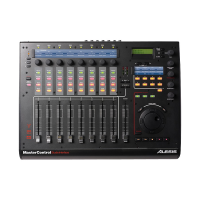Use sawtooth waveforms, have one tuned up an octave higher or so. Someone said that piano have
harmonics in a ratio of 1 to 2.1 I used mainly the 12db BPF with lots of resonance. Which if you
think about it is what makes the piano sound the way it does - the resonance from the body. I also
mixed in a bit of 12db LPF. You'll have to scale stuff according to key number. Then you have
modulate lots of stuff from velocity to add life :)
From Michael Caleroso:
There are several tricks to getting a piano sound on an analog synth:
1. hard sync VCO2 to VCO1 and tune VCO2 at least octave+5th higher than VCO1. I don't
remember the exact tuning in "Frank" but this gets you those harmonics from those wound
strings. Ramp and narrow pulse waveforms work best for sync'd VCOs for oodles of harmonics.
2. use BP mode for the filters, FILTER1 HPF -> FILTER2 LPF. Adjust FILTER2 cutoff, resonance,
and keytracking to taste for reducing the high harmonics. I used FILTER1 to emulate the
resonance of the soundboard in a piano, IE vary resonance and cutoff (tuned near the
fundamental) so that you get some "woodiness" to the tone.
3. Complex envelope - this is where the Andromeda's dual decay and release stages and
selectable slopes are really handy. I spent the most time getting the envelope right, and then
scaling it to key number (see next tip).
4. Modulation, modulation, modulation. Route velocity to FILTER2 cutoff for less harmonics on
softer keystrikes. Route keynumber to pulse width. Or route envelope to PW. Envelope to
prefilter VCO1 level. Keynumber to mix level. Keynumber to FILTER2 resonance. And
keynumber to envelope decay/release, the transients on a real piano are shorter on the higher
notes. The timbre of a piano is complex and dynamic depending on velocity and note, this is
where the Andromeda's vast modulation routing is put to the task.
5. Leave the effects OFF. Get the basic sound first, don't try to voice the piano patch using delays
or reverb. Piano sounds are likely to be used in MIX mode (think layers), so the less you rely on
effects the better.
6. If you have a weighted action MIDI controller, drive the Andromeda with it and check for natural
timbre and response. Check the timbre outside the 61-note keyboard of the A6. You'll be glad
you did when you use the TRANSPOSE feature in MIX mode or by the wheels. My personal
test was "Maple Leaf Rag".
Getting a good piano sound means finding the right combination of all of the above and it's not easy,
especially the modulation stuff. It's a real good analog programming challenge. It's a test of your
imagination. You'll find something that works in the top range but those low notes aren't quite there,
and then a filter tweak or sync'd VCO2 tuning tweak will just move the halfway point around.
LOTS of tweaking. Save often, and save several versions so you come back the next day and find
that the third of seven versions takes you in the direction you wanted in the first place. Don't spend
hours on trying to get one sound, give your ears a rest and come back to it. I'm still refining a
Wurlitzer piano patch, which will be included in the bank I ship off to Alesis.
I've done a couple of variations of "Frankensteinwey", one of which I turned off keyboard tracking of
the sync'd VCO2 and modded the pitch with less than 100% keynumber, which worked for another
style piano I wanted. Experimentation and imagination are the key here. Things I haven't tried are
using the ringmod (what would that sound like with a sync'd VCO?), different filter modes, VCO
crossmod (don't laugh!), filter feedback, etc.
The Andromeda's vast modulation routings and filter variations play a big part in getting a good
piano sound, and it's so fricking cool to have a real analog filter controlling the harmonics with
velocity. Plus the keyboard is semi-weighted and not the featherlight spring action on most other
keyboards. I can't think of another analog synth that has near the tools the Andromeda does for
complex sounds like pianos, and having all those knobs makes it a joy to progam. The SCI T8 was
partway there :)
Like Colin said, if you're a piano player to begin with then you have a better sonic vision of what
you're after :)
From Jordini:
I just got to try out some of y'all's tips and I also believe the envelope is the most important part to
get right. I also tried deconstructing Frankensteinwhey and I thought it was interesting that you
tuned VCO2 way up there in the 5900Hz region. The envelope you believed has a pretty linear

